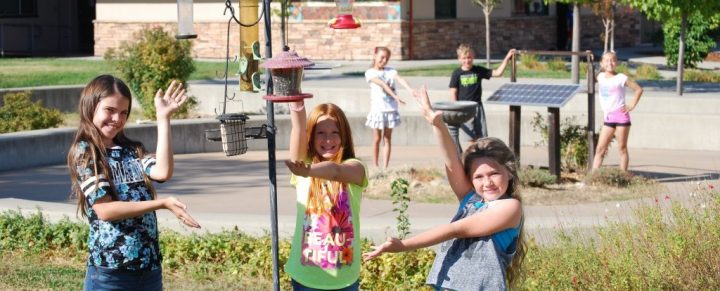Maintaining Your Classroom Feeder

Hanging a bird feeder outside your classroom window not only provides food to your feathered friends, but also engages students in observing and learning about birds and their behaviors. Whether you have multiple classroom feeders or you have yet to hang one up, you may wonder how much maintenance a feeder requires. Fortunately, the answer is very little! These tips and tricks can keep your feeder maintenance to a minimum and keep your birds healthy and coming back for more
1. Clean your Feeder
We recommend that you wash your feeder once every two weeks. Plastic and metal feeders are usually easier to clean and sanitize than wooden feeders are, and some plastic feeders are even dishwasher safe. Additionally, if you see a sick bird at your feeder, you should clean it thoroughly.
- Remove the feeder.
- Soak it in soapy water.
- Rinse it with a solution of 1 part bleach and 9 parts water.
- Dry it completely before refilling and hanging it.
When cleaning your bird feeder, be sure to wear rubber gloves to prevent contamination and avoid spreading disease. Designate a small brush, such as an old toothbrush, for cleaning any nooks and crannies inside the feeder.
2. Avoid Bird-Window Collisions
Window feeders are great opportunities for bird observation and student learning, but windows can be quite dangerous for birds. To keep birds from crashing into your classroom windows, consider hanging something shiny, like old CDs or long reflective streamers, against the glass. Not only will this prevent bird deaths and injuries, it will also save you from cleaning up an unwanted mess on your window and on the ground below.
Window strike mortalities can also be reduced by moving your feeders very close to(within 3 feet) or very far from (greater than 30 feet) your feeder. When feeders are close to a window, a bird leaving the feeder cannot gain enough momentum to do harm if it strikes the window. If feeders are more than 30 feet from a window, the birds are less likely to perceive windows as a pathway to other parts of your yard.
Check out what this group of students is doing to prevent bird-window collisions at their school!
[youtube id=”dyBrDTVyj0Y” size=”large”]3. Reduce Seed Mess
To reduce the mess on the ground below the feeder, use hulled seed (seed whose hard outer shell has been removed). Additionally, rotating feeder location and raking the ground beneath the feeder can reduce mess and keep seeds from sprouting. For seed storage, keep the seed in a dry, dark location in a closed container that can be sealed to prevent rodents from eating the seed and creating a mess.
4. Avoid Crowding
If lots of birds frequent your feeder, consider putting up multiple feeders to avoid overcrowding. If possible, place the feeders in different areas of the schoolyard. This will allow birds to have more room, while also minimizing the transfer of illnesses from sick to healthy birds. Read more about bird diseases from Project Feeder Watch.
5. Maintain Feeders over School Breaks
It is fine to leave feeders empty over weekends or schools breaks! Your bird feeder is one of the many food sources birds use to stock up. There is no risk to bird survival by keeping your feeders empty. However, if you have more than one classroom feeder, it is less likely that they will run out of seed while your class is away.
Going Further:
- Our Pennington Feathered Friends activities are free downloadable lesson plans to accompany your classroom feeder.
- Participate in the Cornell Lab of Ornithology’s citizen-science initiative Project FeederWatch.
- Use our Feeding School Yard Birds handout.